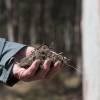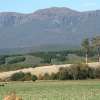
Expert Q&A series: Hear from Technical Forest Services' Justin Baily
Posted 22 June 2021
Managing trees On-farm benefits Economic benefits and markets Carbon benefits Native regrowth forest management PFT
With decades of experience working with a range of farm owners, landowners and managers, Technical Forest Services has been a leading provider in forest industry assessment, management, supervision, and contracting needs for Tasmania and beyond.
With a range of staff from operational, academic, economic and technical forestry backgrounds, the Launceston-based office are industry leaders in forestry services.
We caught up with Technical Forest Services Manager of Compliance, Justin Baily to talk about why trees are helping grow the future of Tasmania’s farms and land for the betterment of not only farms, but the planet as well.
- Why should Tasmania’s farmers and landowners consider planting trees with the intention of harvesting and replanting? I believe farm forestry should not symbolize the locking up of land parcels for decades. Trees on farms can provide a plethora of ecosystem services while providing economic opportunities for farms. Trees can provide shelter and shade for grazing livestock, they can assist with erosion control and also offer enhanced biodiversity. Along with traditional timber markets where trees can be used for fibre and timber fuel, trees can also can give access to natural capital accounting markets and offer carbon credits for industries looking to offset their emissions. There is so much potential and the industry is changing.
- Is there a common misconception from farmers and land owners around planting trees you want to debunk?
In my discussions with farm owners and land managers, my advice is that fibrewood plantations need not be the only forest management tool in a farmer’s forest toolkit. The right trees need to be selected for the right place and for the right purpose.
- What makes Tasmania well positioned to be industry leaders in farm forestry?
It’s all about community. Community is very important to good farm forest management. The community in Tasmania is tight knit and inclusive. I’ve witnessed great neighbor to neighbor and region to region mentorship. There’s great operational synergies and cost sharing, when it comes time to monetise which also brings potential for things like tourism. There is power in teamwork.
- Is there a single recommendation or piece of advice you would offer farmers or landowners who are on the fence about planting trees?
Start small. Determine objectives and outcomes and from those objectives, measure based on outcomes. It doesn’t need to be a large area, it could be planting to repair an eroded spring or shelterbelt, for grazing stock or even to beautify access to the farm.
- Have you seen a change in the farm forestry industry in the last decade?
There has been a move away from traditional plantation tree farms in the farming landscape. There’s been some confusion amongst farmers on which direction to take and what the future of farm forestry in the state should look like. It’s a good conversation to have. Trees on farms needs to be discussed because there’s a future there. Discussions with farmers and land owners need to continue.
- Is there a first-hand account that comes to mind where you’ve seen a farmer or landowner reap the benefits of having planted trees?
In my work, I’ve seen a lot of examples over the years. There are numerous stories across the state that I’ve been involved with.
- If someone is interested in planting trees on their farm/land, what’s something that should be considered that’s often overlooked?
Browsing management is the key to tree planting success. Farmers must do their due diligence in proactive planning for the best outcomes. Farmers have better knowledge of their own property than foresters would, so they would also have a better understanding of browsing management. Reactive management more often than not results in poor survival and poor outcomes.
- What role do you see trees playing in helping protect land for future generations?
Trees manage water movement and play a big role in the carbon cycle and soluble nutrients on a farm. Maintaining productive land through the movement of water over a period of time is future proofing land.
- How can you/your business be of assistance to those interested in planting/harvesting trees?
Technical Forest Services is a third party, independent service provider to the wider industry and we deal with large institutional managers down to private forest owners. We offer planning services, establishment advice, pest management and surveillance, compliance audits, project management services, etc. We try and help out where we can, so we have a good grasp across the entire sector. We have offices in Hobart and Launceston and Mt. Gambier, South Australia.
- How important is it to plant the right trees in the right place?
It’s the key! The right trees planted in the right places and also making sure the trees will meet farm specific objectives.





